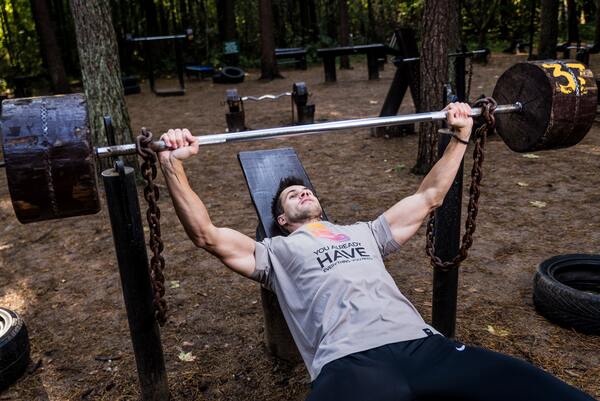Anyone who has ever had elbow pain while bench pressing knows it can be a frustrating experience. The majority of the time, improper technique and overuse of the forearm tendons cause elbow pain when bench pressing. Fortunately, you can overcome it with effective management. Here’s exactly how to go about doing that.
Why Do You Get Elbow Pain While Bench Pressing
When it comes down to the bare minimum, there are two reasons why you might feel elbow pain while bench pressing. The poor technique (also known as a motor control issue) or overuse of your muscles and tendons due to a high, repetitive training volume can both cause it.
Your triceps (including your triceps tendons and triceps extensions) may experience problems as a result, among other places.
Overuse Issues
As you might have guessed, the most common cause of elbow pain in weightlifters is overuse injuries. This is due to the fact that when you are seriously training, you are pushing yourself beyond what you are capable of and forcing your body to work out more than it can.
Fortunately, it is also very simple to treat because it is so widespread. We’ll explain how to treat it as you read on.
Motor Control Issues
As previously mentioned, the term “coordination” is simply used to describe someone’s capacity to plan and carry out the necessary movements.
This, more commonly referred to as your bench technique, refers to your capacity to execute the movement fully without undue stress on particular muscles. Elbow pain is one of the unneeded problems that the improper execution of the movement may be causing you.
Read more: 5 Rules For Wrist Position For Bench Pressing
Identifying The Most Common Conditions Causing Elbow Pain
Tendinopathies Of The Forearm Tendons
Results from: High volume/high loading & repetitive tissue demands of the forearm tendons
You may recall that I mentioned that lifters frequently experience this problem. There is a perfect explanation for this:
In the context of this article, tendinopathy describes a widespread breakdown of the tendons surrounding the elbow. To put it simply, tendonitis is the beginning stage of tendon irritation, and tendonitis is the painful condition that develops after it.
In the context of this article, it most frequently results from high volumes of repetitive movements or demands placed on those tendons, though it can happen for a variety of reasons.
You use those tendons to perform the necessary motions whenever you are gripping a weight or squeezing a barbell.

How To Fix
The thing about a condition like a tendinopathy is that you will need to set aside time to rest and possibly even temporarily change your routine and your workouts in order to fully recover from it. If you choose to proceed in the same manner, you will probably only make it worse, so you will need to apply a lot less pressure to the troublesome muscle group and tendon.
The first and most crucial step is to drastically reduce the pressure you apply to your tendons. If you decide to continue exercising and performing bench presses, you will need to either drastically reduce or completely alter your workout to ensure that your pain is significantly reduced.
Your elbow pain should go away on its own and fairly easy if you take your time to heal and reduce the intensity of your sets, depending on the severity of the injury.
To compensate for the rest you are giving your elbow, all you really need to do is be patient and watch out that you don’t overwork your other muscles or tendons by doing so.
Bursitis Of The Elbow
Results from: Excessive or repetitive pressure placed on the back of the elbow against a hard surface, such as when doing floor press.
Bursitis is a condition that is closely related to the tendinopathy classification. Actually, bursas, which resemble tiny water balloons, are present in our bodies in numbers of well over a hundred.
These tiny creatures serve as tendons’ friction reducers, enabling tendons to smoothly glide over other tissues without suffering irritation from friction.
The issue is that these tiny discs, which resemble water balloons, are actually prone to irritation and inflammation. Pain typically manifests when this happens. When someone has elbow bursitis, the olecranon bursa, one of the bursa pads, becomes inflamed and quite painful.
In reality, the olecranon is the part of the body where bursitis occurs most frequently. Despite the pain it can cause, it often appears to be a little more severe than it really is. Olecranon bursitis is the most likely cause of the elbow’s tip looking like it has a soggy golf ball under the skin.
How To Fix
Similar steps are taken to address this problem and the one mentioned above. This means that if you have bursitis, you must stop doing all of the exercises right away that might be putting too much pressure on your elbow, especially exercises like floor presses.
You should not be using NSAID medications to treat bursitis because it is an inflammatory condition. You can buy an over-the-counter anti-inflammatory and use it up until your condition starts to get better.
The excess fluid in your elbow can also be helped to drain by gently compressing it as often as you can. As you get better and continue your regular workouts, you can even go so far as to wear an elbow sleeve to see results more quickly.
Fixing Poor Bench Press Technique
Many times, people who have never bench pressed or who haven’t taken the exercise seriously are unable to comprehend the world of technique and subsequent motor control that goes into bench pressing.
The perfect technique not only increases the number of repetitions you can complete in a single set by a significant amount, but it also significantly reduces the chance that elbow pain will develop.
Never undervalue the value of perfect technique; no matter how experienced they are, even the world’s top bench pressers and powerlifters are constantly striving to tighten and improve their form.
You should follow suit because repetitive movement errors, even relatively minor ones like grip width, chest placement, and bar path, can all negatively impact the health of your elbows.
How To Fix
Fortunately, there are many things you can actively do to correct a poor bench press technique. To do this, all you need to do is get a camera (or your phone) and record yourself performing a bench press.
Then, you can actually rewind and watch yourself doing it to see if you can spot anything that is incorrect. Even professional examples can be compared in videos. Simply ensure that you are getting a good angle to see everything that is happening with your bench pressing technique.
What Is A Good Bench Press Alternative To Avoid Elbow Pain
Here are six effective bench press substitutes to prevent elbow pain:
- Chest flies made of cable (variations: standing, flat, incline, decline)
- Cable crossover
- Machine chest flys
- Dumbbell flies
- Push-Ups
- Dumbbell Pullovers
All of these exercises reduce stress on the elbow-connected forearm extensor tendon. Likewise the triceps brachii tendon. This can prevent posterior elbow pain from benching-related tennis elbow or triceps tendonitis.
Final Thoughts
There are several reasons why your elbow might be experiencing some pain when you are bench pressing, and it is important to understand them if you are going to be a responsible bodybuilder. Don’t be afraid to take some time to consider the cause of your pain.
Read More: Bench Press VS Dips: Which Is Better?
